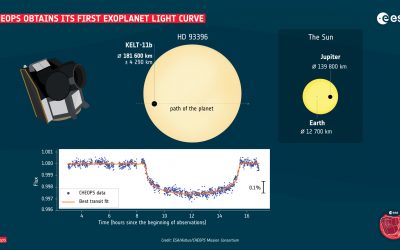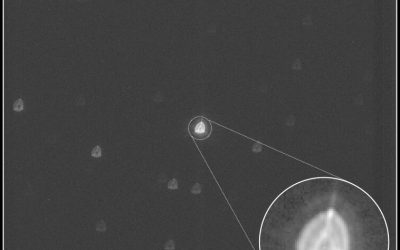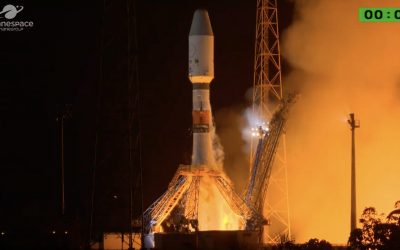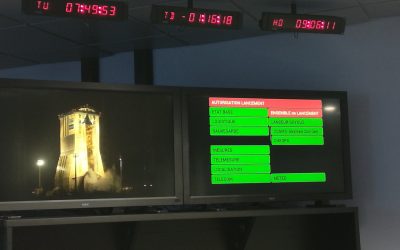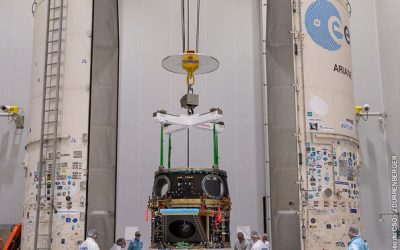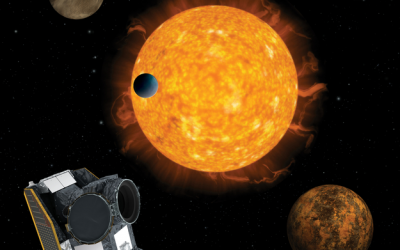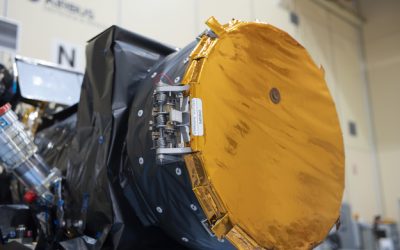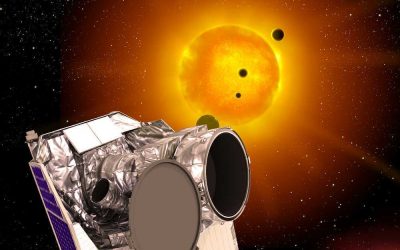CHEOPS
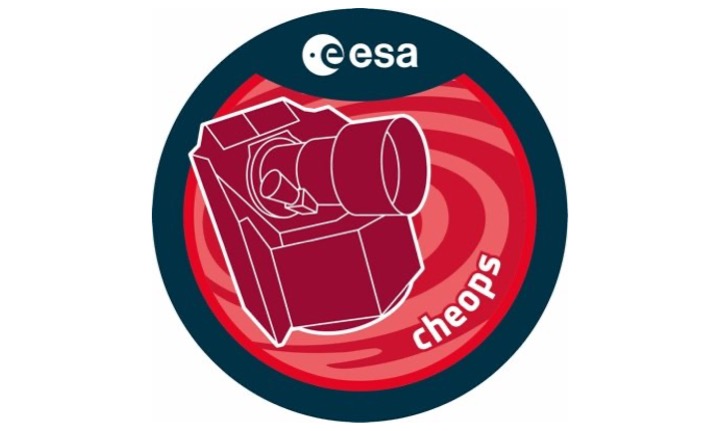
Principal Investigator:
Willy Benz
Responsabile Nazionale:
Isabella Pagano
Referente locale:
Isabella Pagano
La partecipazione italiana al progetto è finanziata con Accordo ASI-INAF n. 2019-29-HH.0 del 26 novembre 2019.
CHEOPS (CHaracterizing ExOPlanet Satellite) has been proposed as an S-class mission in response to the call for Proposals issued by ESA in March 2012. It has been selected by ESA as the first S-class mission in Cosmic Vision 2015-2025. The mission has been adopted in 2014, and launched on Dec 18 2019.
CHEOPS is a joint ESA-Switzerland project, with important contribution from Italy and nine other ESA Member States, cooperating within a dedicated Mission Consortium.
It is the first mission dedicated to the characterisation of small-size transiting planets by means of ultrahigh precision photometry on bright stars already known to host planets. It enables an accurate determination of the radii of transiting planets, for which the mass has already been measured from ground-based spectroscopic surveys. It also provides precision radii for new planets discovered by the next generation of ground-based transits surveys (Neptune-size and smaller).
For the first time, CHEOPS enables comparative planetology in an unexplored mass range at a precision never before achieved. CHEOPS contribute also to better select the targets for future ground- (e.g. E-ELT) and space-based (e.g. JWST, Ariel) facilities with spectroscopic capabilities for atmospheric characterisation.
Italy has a role of primary importance in Cheops, both for its contribution to the instrument and for its scientific contribution. The researchers of INAF – Astrophysical Observatory of Catania and Astronomical Observatory of Padua – developed the optical project of the telescope, and supported the industry selected by Italian Space Agency (ASI) – a group of companies formed by Leonardo SrL (lead partner), Thales Italia and MediaLario – for the realization of the mirrors, the back-end optics, and for the integration, alignment and test of the telescope. The flight model was delivered by Italy to the Cheops Consortium – led by the University of Bern – in May of 2017.
The INAF team also contributed in an original way to all the scientific preparation phases of the Cheops telescope: writing the scientific requirements, their transposition into technical requirements and their verification; elaboration of the model and analysis of stray light, the requirements of which are very stringent; study of the optical performance of the instrument and eventually contributed to the implementation and validation of data reduction procedures. Finally, in collaboration with colleagues from the University of Padua, and with the scientific team of the Cheops consortium, the INAF researchers participated in the formulation and preparation of the scientific program on guaranteed time (80% of the observing time).
MISSION SUMMARY
Name: CHEOPS, CHaracterizing ExOPlanet Satellite Primary
Goal: Characterize transiting exoplanets on known bright and nearby host stars
Targets: Known exoplanet host stars with a V-magnitude < = 12 anywhere on the sky
Wavelength: Visible range : 330 to 1100 nm
Telescope: 33 cm reflective on-axis telescope; 19×19 arcmin^2 field of view
Orbit: Sun-synchronous, dusk-dawn orbit at 700 km above Earth
Lifetime: 3.5 years (5 years goal)
Satellite: 1.5 m size; 280 Kg mass
Type: S (small)-class mission
Principali altri enti coinvolti oltre INAF
Persone OACT coinvolte nel progetto:
Isabella Pagano, Giovanni Bruno, Flavia Calderone, Antonino F. Lanza, Giuseppe Leto, Matteo Munari, Gaetano Scandariato, Daniela Sicilia, Vikash Singh
Articoli correlati
Esopianeti, avanti: Cheops è pronto a misurarvi
Prendono il via le operazioni scientifiche della missione spaziale Esa per la caratterizzazione dei pianeti extrasolari, che vede un’importante partecipazione italiana. Roberto Ragazzoni (Inaf Padova): «Le sue soluzioni non ortodosse sono state premiate, dimostrando di offrire una precisione fotometrica anche superiore alle specifiche».
Quel diamante sfocato è la prima stella di Cheops
Il telescopio spaziale dell’Esa per la caratterizzazione degli esopianeti ha acquisito un’immagine della sua prima stella bersaglio. Raffigura Hd 70843, una sorgente a 150 anni luce da noi, ed è stata deliberatamente sfocata dall’ottica dello strumento per migliorare la precisione della misura della quantità di luce emessa.
Lancio avvenuto, Cheops è in volo
Lanciato alle 9:54 ora italiana dallo spazioporto di Kourou, in Guyana francese, a bordo di un razzo Soyuz, Cheops osserverà più di 7mila stelle nei 3 anni e mezzo di durata nominale della missione. Missione a importante partecipazione dell’Italia, con l’Inaf, l’Università di Padova e l’Asi, sarà il nostro misura-pianeti, un satellite dedicato alla caratterizzazione di mondi di piccole dimensioni.
Lancio rimandato per Cheops
Un problema al software del lanciatore emerso durante la sequenza di lancio. Questa pare sia la ragione che ha costretto ArianeSpace a rimandare – almeno fino a domani, mercoledì 18 dicembre – la partenza del Soyuz con a bordo il telescopio spaziale Cheops per la caratterizzazione degli esopianeti.
Cheops prende posto sul Soyuz
Incapsulato all’interno del modulo di trasporto del lanciatore Soyuz insieme a uno dei satelliti della costellazione italiana Cosmo-SkyMed, il telescopio spaziale europeo per lo studio degli esopianeti è pronto a spiccare il volo il 17 dicembre.
Cheops: il team europeo è pronto
Questo telescopio spaziale made in Italy si dedicherà alla ricerca di pianeti transienti. L’Italia ha un importante ruolo nella missione. Ingegneri e scienziati sono pronti al lancio, previsto per questo autunno.
Cheops è pronto al lancio
La missione Cheops dell’Esa dedicata alla caratterizzazione dei pianeti extrasolari ha superato brillantemente un’importante review: il satellite è pronto per il volo. Il lancio è previsto tra sette mesi dalla Guiana francese. Media Inaf ha raggiunto, per l’occasione, due scienziati della missione, Isabella Pagano dell’Inaf di Catania e Roberto Ragazzoni dell’Inaf di Padova.
Cheops, meno di un anno al lancio
L’Agenzia spaziale europea ha fissato la finestra di lancio della durata di un mese per il “Characterising Exoplanet Satellite”: lascerà la Terra a partire dal 15 ottobre 2019, con un lanciatore Soyuz, dallo spazioporto di Kourou.
Contatti
Osservatorio Astrofisico di Catania
Via Santa Sofia 78, 95123 Catania, Italia
(+39) 095.7332111
segreteria.direzione.oact@inaf.it
(PEC): inafoacatania@pcert.postecert.it
Per informazioni sul nostro sito: web.oact@inaf.it
Per informazioni sulla didattica e divulgazione: divulgazione.oact@inaf.it
